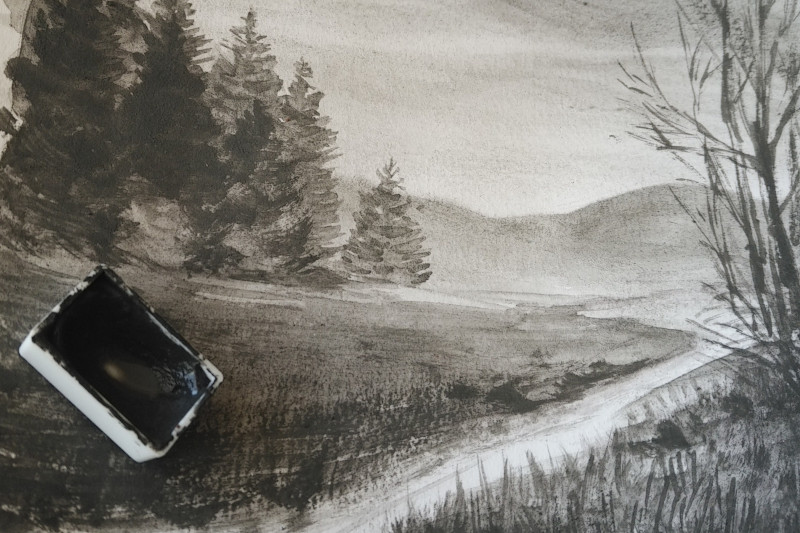Slate watercolor paint

Wouldn’t it be wonderful to paint a landscape with materials the land is made of? Slate was the first that came to my mind since I have long wondered about the impression that it gives at dusk, when it shines blue against receding colors of surrounding nature.
This is not a guide for how it should be done, this is a description of how I tried to do it.
Materials
Pigment:
- pieces of slate
- huge hammer
- eye protection
- water
- containers
Paint:
- gum arabic
- glycerine
- distilled water
- tea tree oil
- glass surface
- palette knife
- containers
Making the pigment
I collected some rocks! Carefully I selected those darkest and most vibrant, but I don’t know whether it mattered. I knew that slate is hard and I might not be able to make pigment of it, so I collected also some brick pieces, you can read about their fate here .
I placed them on a big slightly concave stone in began to crush them with a huge hammer (use eye protection). At first, I thought I’ll put them into a fabric and crush it into smaller pieces all at once. But the fabric got quickly destroyed by the sharp edges and the rocks were flying away too much.

So I needed to crush them in a more controlled manner by a really small amount at a time. The smaller the rocks were, the easier it got, until I was half crushing half grinding the smallest pieces. I was careful to collect as much of the finest dust as I could. This took several days.

The result of the hammer treatment was a mix of various sizes. I thought I would separate the smallest ones using a sieve, but it was making a lot of dust, which was bad, because dust are my finest particles. So I added a little water, thinking the particles will be less likely to fly away. And they were, but they also got glued by the water to the larger ones and no longer went through the sieve.
While waiting for the whole batch to dry again, I took the small sample that went through the sieve and attempted to grind it more in mortar and pestle. I couldn’t, slate is just too hard.
Which solved my sieving problem, why would I separate particles I can’t use further.
I took all the material that I had, put it into a bucket with water, and stirred it to suspend the smallest particles into the water. Then I poured the water into another bucket, careful not to pour the bigger particles too. iWhen the particles in the second bucket settled, I poured out some of the water, careful not to lose any particles. I expected to be left with a bunch of nice tiny particles in the second bucket when the water is gone.

To encourage the water to go away from the bucket, I hung a wet fabric rope over its edge. I was surprised how well it worked and in a few days there was a nice slate paste. The ridges on the picture were made by the fabric rope.

I transferred the beautiful mud into a small jar. At this stage, I started to think I might actually succeed at making the paint.

And here is the finished dry nice delicate pigment.

Making the paint
I crushed the gum arabic chunks into smaller ones and then I put one part of gum arabic into two parts of distilled water. The recipes say to add clove oil against molding, but I don’t have it, so I added two drops of tea tree oil. I wanted to add two drops, but some more fell in, I don’t know what effect it may have. I stirred the result, then closed it with a lid and put it into the fridge.

A day or two later the gum arabic really dissolved, so I added a little less than one part of glycerine and the solution was ready! I made a pigment hill with a dip in the center of my glass surface which used to be a picture frame, then I poured the binder solution into the dip. I had no idea how much there should be, but I hoped to be able to adjust it later.

Now with a palette knife, I mixed the pigment with the binder, collected it into the center, and mixed again. I also tried mulling it, I don’ŧ have a muller, but I found a round thing with a flat bottom side, which I could use. It was gritty and it didn’t get less gritty over time, but it was good for spreading the pigment evenly.

When I had enough I used the palette knife to collect the result - PAINT! into pans. I found the knife’s edge and flexibility very useful for this task, since the paint was very sticky.

I am a little disapointed with the color, it is a bleak gray city depression. I also must have done something wrong with the formula, it feels like a cheap paint in that it is hard to get a concentrated color (too much binder?), it is also hard to rewet (too little glycerine?) and feels like a brush destroyer.
